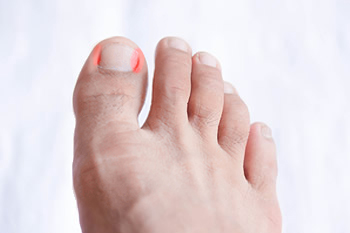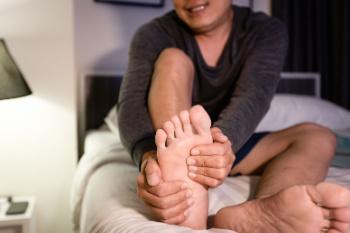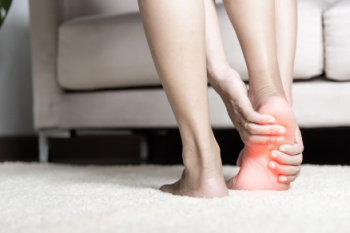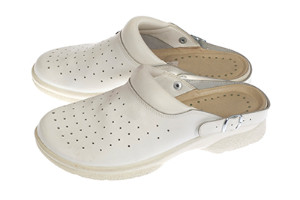Connect With Us
Blog
Items filtered by date: July 2025
Ankle Injuries From Ballet Dancing

Ankle injuries are particularly common among dancers, especially those who perform ballet. Movements such as dancing en pointe place the ankle in a highly pointed position, which can strain the ligaments and muscles that support the joint. One of the most frequent ballet injuries is a lateral ankle sprain, which affects the outer part of the ankle. While many sprains heal with time, some leave behind lasting issues like instability or repeated injuries. Ballet dancers rely heavily on their ankles for balance, precision, and strength, making them more vulnerable to ongoing problems if a sprain is not fully resolved. The muscles along the outside of the ankle, known as the peroneals, work hard to stabilize the foot during dance. When these muscles are overused, especially after an ankle injury, tendinitis can develop, causing pain and weakness. A podiatrist can help diagnose these issues and recommend treatment to improve stability and reduce discomfort. If you have injured an ankle, it is suggested that you schedule an appointment with a podiatrist for a diagnosis and appropriate treatment.
Ankle pain can be caused by a number of problems and may be potentially serious. If you have ankle pain, consult with James Torhorst, DPM from Torhorst Foot and Ankle. Our doctor will assess your condition and provide you with quality foot and ankle treatment.
Ankle pain is any condition that causes pain in the ankle. Due to the fact that the ankle consists of tendons, muscles, bones, and ligaments, ankle pain can come from a number of different conditions.
Causes
The most common causes of ankle pain include:
- Types of arthritis (rheumatoid, osteoarthritis, and gout)
- Ankle sprains
- Broken ankles
- Achilles tendonitis
- Achilles tendon rupture
- Stress fractures
- Bursitis
- Tarsal tunnel syndrome
- Plantar fasciitis
Symptoms
Symptoms of ankle injury vary based upon the condition. Pain may include general pain and discomfort, swelling, aching, redness, bruising, burning or stabbing sensations, and/or loss of sensation.
Diagnosis
Due to the wide variety of potential causes of ankle pain, podiatrists will utilize a number of different methods to properly diagnose ankle pain. This can include asking for personal and family medical histories and of any recent injuries. Further diagnosis may include sensation tests, a physical examination, and potentially x-rays or other imaging tests.
Treatment
Just as the range of causes varies widely, so do treatments. Some more common treatments are rest, ice packs, keeping pressure off the foot, orthotics and braces, medication for inflammation and pain, and surgery.
If you have any questions, please feel free to contact our offices located in Waupaca and Stevens Point, WI . We offer the newest diagnostic and treatment technologies for all your foot care needs.
Why Live with Pain and Numbness in Your Feet?
Signs You May Have an Ingrown Toenail

An ingrown toenail develops when the edge of the nail grows into the surrounding skin instead of over it. This often causes tenderness, swelling, and redness along one or both sides of the nail, most commonly on the big toe. In the early stages, the area may feel sore when pressure is applied, especially while wearing shoes. As it progresses, the skin may become inflamed or even show signs of infection such as warmth, pus, or increased pain. Trimming nails too short or at an angle, wearing tight footwear, or stubbing the toe can contribute to the problem. Left untreated, an ingrown toenail may worsen and lead to further complications. If you notice ongoing pain, swelling, or signs of infection near the edge of your toenail, it is suggested that you see a podiatrist to receive proper care and avoid further irritation.
Ingrown toenails may initially present themselves as a minor discomfort, but they may progress into an infection in the skin without proper treatment. For more information about ingrown toenails, contact James Torhorst, DPM of Torhorst Foot and Ankle. Our doctor can provide the care you need to keep you pain-free and on your feet.
Ingrown Toenails
Ingrown toenails are caused when the corner or side of a toenail grows into the soft flesh surrounding it. They often result in redness, swelling, pain, and in some cases, infection. This condition typically affects the big toe and may recur if it is not treated properly.
Causes
- Improper toenail trimming
- Genetics
- Improper shoe fitting
- Injury from pedicures or nail picking
- Abnormal gait
- Poor hygiene
You are more likely to develop an ingrown toenail if you are obese, have diabetes, arthritis, or have any fungal infection in your nails. Additionally, people who have foot or toe deformities are at a higher risk of developing an ingrown toenail.
Symptoms
Some symptoms of ingrown toenails are redness, swelling, and pain. In rare cases, there may be a yellowish drainage coming from the nail.
Treatment
Ignoring an ingrown toenail can have serious complications. Infections of the nail border can progress to a deeper soft-tissue infection, which can then turn into a bone infection. You should always speak with your podiatrist if you suspect you have an ingrown toenail, especially if you have diabetes or poor circulation.
If you have any questions, please feel free to contact our offices located in Waupaca and Stevens Point, WI . We offer the newest diagnostic and treatment technologies for all your foot care needs.
Simple Ways to Ease Plantar Fasciitis Through Movement

Plantar fasciitis occurs when the thick band of tissue along the bottom of the foot becomes irritated, often causing heel pain. Stretching and strengthening can play an important role in easing the discomfort caused by plantar fasciitis. One helpful stretch involves gently pulling the toes toward the shin while seated, which helps loosen the band of tissue along the sole. Rolling the foot slowly over a firm object, such as a frozen water bottle or massage ball, may also reduce tightness. Calf stretches done against a wall can help relieve pressure on the heel by improving flexibility in the lower leg. In addition to stretching, strengthening the small muscles of the foot with towel scrunches or toe raises may provide better support. These exercises are most effective when done regularly and combined with wearing supportive footwear. Plantar fasciitis can cause extreme pain and discomfort, making it difficult to complete daily tasks. If you have heel pain, it is suggested that you see a podiatrist who can provide effective relief and treatment solutions for plantar fasciitis.
Plantar fasciitis can be very painful and inconvenient. If you are experiencing heel pain or symptoms of plantar fasciitis, contact James Torhorst, DPM from Torhorst Foot and Ankle. Our doctor can provide the care you need to keep you pain-free and on your feet.
What Is Plantar Fasciitis?
Plantar fasciitis is the inflammation of the thick band of tissue that runs along the bottom of your foot, known as the plantar fascia, and causes mild to severe heel pain.
What Causes Plantar Fasciitis?
- Excessive running
- Non-supportive shoes
- Overpronation
- Repeated stretching and tearing of the plantar fascia
How Can It Be Treated?
- Conservative measures – anti-inflammatories, ice packs, stretching exercises, physical therapy, orthotic devices
- Shockwave therapy – sound waves are sent to the affected area to facilitate healing and are usually used for chronic cases of plantar fasciitis
- Surgery – usually only used as a last resort when all else fails. The plantar fascia can be surgically detached from the heel
While very treatable, plantar fasciitis is definitely not something that should be ignored. Especially in severe cases, speaking to your doctor right away is highly recommended to avoid complications and severe heel pain. Your podiatrist can work with you to provide the appropriate treatment options tailored to your condition.
If you have any questions please feel free to contact our offices located in Waupaca and Stevens Point, WI . We offer the newest diagnostic and treatment technologies for all your foot and ankle needs.
Common Causes of Heel Pain

Heel pain often comes from a few common issues in the foot and heel area. One frequent cause of heel pain is plantar fasciitis, which involves micro‑tears in the fibrous band under the foot where it meets the heel bone. Heel spurs can develop as a bone growth at that same connection. Although sometimes symptomless, they can accompany ongoing plantar fascia discomfort. In active adolescent children, Sever’s disease is caused by inflammation of the growth plate at the back of the heel. It typically occurs when their activity level increases or from wearing improper footwear. Wearing tight shoes can cause a so-called pump bump on the back of the heel, which can become painful when walking. A podiatrist can evaluate these sources of heel pain with an exam and imaging tests to determine a treatment plan. If you are experiencing persistent heel pain, it is suggested that you schedule an appointment with a podiatrist for a diagnosis and appropriate treatment.
Many people suffer from bouts of heel pain. For more information, contact James Torhorst, DPM of Torhorst Foot and Ankle. Our doctor can provide the care you need to keep you pain-free and on your feet.
Causes of Heel Pain
Heel pain is often associated with plantar fasciitis. The plantar fascia is a band of tissues that extends along the bottom of the foot. A rip or tear in this ligament can cause inflammation of the tissue.
Achilles tendonitis is another cause of heel pain. Inflammation of the Achilles tendon will cause pain from fractures and muscle tearing. Lack of flexibility is also another symptom.
Heel spurs are another cause of pain. When the tissues of the plantar fascia undergo a great deal of stress, it can lead to ligament separation from the heel bone, causing heel spurs.
Why Might Heel Pain Occur?
- Wearing ill-fitting shoes
- Wearing non-supportive shoes
- Weight change
- Excessive running
Treatments
Heel pain should be treated as soon as possible for immediate results. Keeping your feet in a stress-free environment will help. If you suffer from Achilles tendonitis or plantar fasciitis, applying ice will reduce the swelling. Stretching before an exercise like running will help the muscles. Using all these tips will help make heel pain a condition of the past.
If you have any questions please contact our offices located in Waupaca and Stevens Point, WI . We offer the newest diagnostic and treatment technologies for all your foot and ankle needs.
Why Bargain Shoes May Lead to Bigger Problems

Shoes made with low-quality materials or poor construction may seem appealing due to their price, but they can take a toll on your foot health, over time. Without proper support, cushioning, or fit, these shoes may contribute to fatigue, pain, and misalignment in the feet and legs. Flat soles and flimsy arch support can lead to overuse injuries or worsen existing conditions, such as heel pain or hammertoes. Wearing unsupportive footwear regularly may also affect posture and place added strain on the knees, hips, or lower back. Replacing shoes frequently or seeking treatment for chronic foot issues can become more expensive than investing in proper footwear from the start. If you are experiencing foot discomfort that may be related to your shoes, it is suggested that you consult a podiatrist for expert advice, care, and qualities to look for in good shoes.
Foot Pain
Foot pain can be extremely painful and debilitating. If you have a foot pain, consult with James Torhorst, DPM from Torhorst Foot and Ankle. Our doctor will assess your condition and provide you with quality foot and ankle treatment.
Causes
Foot pain is a very broad condition that could be caused by one or more ailments. The most common include:
- Bunions
- Hammertoes
- Plantar Fasciitis
- Bone Spurs
- Corns
- Tarsal Tunnel Syndrome
- Ingrown Toenails
- Arthritis (such as Gout, Rheumatoid, and Osteoarthritis)
- Flat Feet
- Injury (from stress fractures, broken toe, foot, ankle, Achilles tendon ruptures, and sprains)
- And more
Diagnosis
To figure out the cause of foot pain, podiatrists utilize several different methods. This can range from simple visual inspections and sensation tests to X-rays and MRI scans. Prior medical history, family medical history, and any recent physical traumatic events will all be taken into consideration for a proper diagnosis.
Treatment
Treatment depends upon the cause of the foot pain. Whether it is resting, staying off the foot, or having surgery; podiatrists have a number of treatment options available for foot pain.
If you have any questions, please feel free to contact our offices located in Waupaca and Stevens Point, WI . We offer the newest diagnostic and treatment technologies for all your foot care needs.

